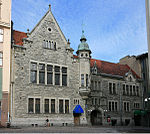Statue of Johan Ludvig Runeberg
Bronze sculptures in FinlandStatues and sculptures in HelsinkiStatues in Finland

The Statue of Johan Ludvig Runeberg is a statue dedicated to the Finland-Swedish author, national poet and priest Johan Ludvig Runeberg (1804–1877), designed and sculpted by his son Walter Runeberg (1838–1920). The statue is located in the Esplanadi park in Helsinki.
Excerpt from the Wikipedia article Statue of Johan Ludvig Runeberg (License: CC BY-SA 3.0, Authors, Images).Statue of Johan Ludvig Runeberg
Kluuvikatu, Helsinki Kaartinkaupunki (Southern major district)
Geographical coordinates (GPS) Address Website External links Nearby Places Show on map
Geographical coordinates (GPS)
| Latitude | Longitude |
|---|---|
| N 60.16749 ° | E 24.9476 ° |
Address
Johan Ludvig Runeberg
Kluuvikatu
00130 Helsinki, Kaartinkaupunki (Southern major district)
Finland
Open on Google Maps











